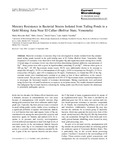| dc.rights.license | http://creativecommons.org/licenses/by-nc-sa/3.0/ve/ | |
| dc.contributor.author | Ball Vargas, María Mercedes | |
| dc.contributor.author | Yarzábal R., Luis A. | |
| dc.contributor.author | Carrero M., Pablo E. | |
| dc.contributor.author | Castro, David | |
| dc.date.accessioned | 2009-07-29T22:29:03Z | |
| dc.date.available | 2009-07-29T22:29:03Z | |
| dc.date.issued | 2007-02-01 | |
| dc.identifier.citation | DOI: 10.1007/s00284-006-0347-4 | es_VE |
| dc.identifier.uri | http://www.saber.ula.ve/handle/123456789/29070 | |
| dc.description.abstract | Bacterial resistance to mercury (Hg) was investigated in strains isolated from Hg-contaminated tailing ponds located in the gold mining area of El Callao (Bolívar State, Venezuela). High frequencies of resistance were detected to both inorganic-Hg and organomercurials among these strains. A broad range of resistance levels was observed when determining minimal inhibitory concentrations of Hg2+. Some strains were able to grow in liquid medium containing 25 μM</Emphasis> Hg2+, whereas others grew at 300 μM</Emphasis> Hg2+. Of 190 Hg-resistant strains tested, 58.2% were additionally shown to be resistant to ampicillin (40 mg/L), 33.3% to chloramphenicol (30 mg/L), 24.9% to streptomycin (30 mg/L), 23.3% to tetracycline (30 mg/L), and 1.6% to kanamycin (30 mg/L). Furthermore, we found that 20% of the Hg-resistant strains were simultaneously resistant to as many as four of these antibiotics, at the concentrations tested. The presence of large plasmids in 62.9% of 53 Hg-resistant strains screened prompted us to investigate the horizontal transfer of resistance determinants. Mating experiments were performed using Escherichia coli and Pseudomonas aeruginosa as recipient strains. The results obtained confirmed that indigenous Hg-resistant bacteria colonizing the tailing ponds can effectively transfer the phenotype to potentially pathogenic species. | es_VE |
| dc.language.iso | en | es_VE |
| dc.publisher | Current Microbiology 2007 Feb;54(2):149-54 | es_VE |
| dc.rights | info:eu-repo/semantics/openAccess | |
| dc.title | Mercury resistance in bacterial strains isolated from tailing ponds in a gold mining area near El Callao (Bolívar State, Venezuela) | es_VE |
| dc.type | info:eu-repo/semantics/article | |
| dc.description.colacion | 149-154 | es_VE |
| dc.description.email | mball@ula.ve | es_VE |
| dc.description.email | yluis@ula.ve | es_VE |
| dc.description.email | pcarrero@ula.ve | es_VE |
| dc.subject.facultad | Facultad de Ciencias | es_VE |
| dc.subject.thematiccategory | Física | es_VE |
| dc.subject.thematiccategory | Química | es_VE |
| dc.subject.tipo | Artículos | es_VE |
| dc.type.media | Texto | es_VE |


